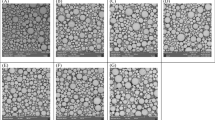Abstract
Purpose. The aim of this work was to understand the mechanism by which co-encapsulated PEG 400 improved the stability of NGF and allowed a continuous release from PLGA 37.5/25 microspheres.
Methods. Microparticles were prepared according to the double emulsion method. PEG 400 was added with NGF in the internal aqueous phase (PEG/PLGA ratio 1/1 and 1.8/1). Its effect was investigated through interfacial tension studies. Protein stability was assessed by ELISA.
Results. A novel application of PEG in protein stabilization during encapsulation was evidenced by adsorption kinetics studies. PEG 400 limited the penetration of NGF in the interfacial film of the primary emulsion. Consequently, it stabilized the NGF by reducing the contact with the organic phase. In addition, it avoided the NGF release profile to level off by limiting the irreversible NGF anchorage in the polymer layers. On the other hand, the amount of active NGF released in the early stages was increased. During microparticle preparation, NaCl could be added in the external aqueous phase to modify the structure of microparticles. This allowed to reduce the initial release rate without affecting the protein stability always encountered in the absence of PEG.
Conclusions. PEG 400 appeared of major interest to achieve a continuous delivery of NGF over seven weeks from biodegradable microparticles prepared by the double emulsion technique.
Similar content being viewed by others
REFERENCES
P. J. Camarata, R. Suryanarayanan, D. A. Turner, R. G. Parker, and T. J. Ebner. Sustained release of nerve growth factor from biodegradable polymer microspheres. Neurosurgery 30:313-319 (1992).
S. Mittal, A. Cohen, and D. Maysinger. In vitro effects of brain derived neurotrophic factor released from microspheres. Neuroreport 5:2577-2582 (1994).
C. E. Krewson, R. Dause, M. Mak, and W. M. Saltzman. Stabilization of nerve growth factor in controlled release polymers and tissue. J. Biomater. Sci. Polym. Ed. 8:103-117 (1996).
D. Maysinger, K. Krieglstein, J. Filipovic-Grcic, M. Sendtner, K. Unsicker, and P. Richardson. Microencapsulated ciliary neurotrophic factor: physical properties and biological activities. Exp. Neurol. 138:177-188 (1996).
J. M. Péan, M. C. Venier-Julienne, R. Filmon, M. Sergent, R. Phan-Tan-Luu, and J. P. Benoit. Optimization of HSA and NGF encapsulation yields in PLGA microparticles. Int. J. Pharm. 166:105-115 (1998).
J. M. Péan, M. C. Venier-Julienne, F. Boury, P. Menei, B. Denizot, and J. P. Benoit. NGF release from poly(d,l-lactide-co-glycolide) microspheres. Effect of some formulation parameters on encapsulated NGF stability. J. Contr. Rel. 56:175-187 (1998).
J. Herrmann and R. Bodmeier. The effect of particle microstructure on the somatostatin release from poly(lactide) microspheres prepared by a W/O/W solvent evaporation method. J. Contr. Rel. 36:63-71 (1995).
T. Uchida, K. Yoshida, A. Ninomiya, and S. Goto. Optimization of preparative conditions for polylactide (PLA) microspheres containing ovalbumin. Chem. Pharm. Bull. 43:1569-1573 (1995).
J. L. Cleland and A. J. S. Jones. Stable formulations of recombinant human growth hormone and interferon-gamma for microencapsulation in biodegradable microspheres. Pharm. Res. 13:1464-1475 (1996).
L. Chen, R. N. Apte, and S. Cohen. Characterization of PLGA microspheres for the controlled delivery of IL-1α for tumor immunotherapy. J. Contr. Rel. 43:261-272 (1997).
P. Johansen, Y. Men, R. Audran, G. Corradin, H. P. Merkle, and B. Gander. Improving stability and release kinetics of microencapsulated tetanus toxoid by co-encapsulation of additives. Pharm. Res. 15:1103-1110 (1998).
J. Nanduri, S. M. Vroegop, S. E. Buxser, and K. E. Neet. Immunological determinants of nerve growth factor involved in p140 trk (Trk) receptor binding. J. Neurosci. Res. 37:433-444 (1994).
F. Boury, T. Ivanova, I. Panaïotov, J. E. Proust, A. Bois, and J. Richou. Dilatational properties of adsorbed poly(D,L-lactide) and bovine serum albumin monolayers at the dichloromethane/water interface. Langmuir 11:1636-1644 (1995).
J. E. Proust, F. Boury, P. Saulnier, J. P. Benoit, I. Panaïotov, and T. Ivanova. Structure, morphology and degradation of poly(α-hydroxy acid)s microspheres in relation with monolayers. Curr. Top. Coll. Int. Sci. 1:195-224 (1997).
F. Boury, H. Marchais, J. E. Proust, and J. P. Benoit. Bovine serum albumin release from poly(α-hydroxy acid) microspheres: effects of polymer molecular weight and surface properties. J. Contr. Rel. 45:75-86 (1997).
T. Verrecchia, P. Huve, D. Bazile, M. Veillard, G. Spenlehauer, and P. Couvreur. Adsorption/desorption of human serum albumin at the surface of poly(lactic acid) nanoparticles prepared by a solvent evaporation process. J. Biomed. Mater. Res. 27:1019-1028 (1993).
R. R. Almon and S. Varon. Associations of beta nerve growth factor with bovine serum albumin as well as with the alpha and gamma subunits of the 7S macromolecule. J. Neuroch. 30:1559-1567 (1978).
T. Arakawa and S. N. Timasheff. Mechanism of poly(ethylene glycol) interaction with proteins. Biochemistry 24:6756-6762 (1985).
K. Lim and J. N. Herron. Molecular simulation of protein-PEG interaction. In J. M. Harris (eds), Poly(ethylene glycol) chemistry, biotechnical and biomedical application, Plenum Press, New York, 1992, pp. 29-55.
J. M. Harris. Introduction to biotechnical and biomedical applications of poly(ethylene glycol). In J. M. Harris (eds), Poly(ethylene glycol) chemistry, biotechnical and biomedical application, Plenum Press, New York, 1992, pp. 1-12
M. Katakam, L. N. Bell, and A. K. Banga. Effect of surfactants on the physical stability of recombinant human growth hormone. J. Pharm. Sci. 84:713-716 (1995).
T. G. Park, W. Lu, and G. Crotts. Importance of the in vitro experimental conditions on protein release kinetics, stability and polymer degradation in protein encapsulated poly(D,L-lactic acid-co-glycolic acid) microspheres. J. Contr. Rel. 33:211-222 (1995).
Author information
Authors and Affiliations
Corresponding author
Rights and permissions
About this article
Cite this article
Péan, JM., Boury, F., Venier-Julienne, MC. et al. Why Does PEG 400 Co-Encapsulation Improve NGF Stability and Release from PLGA Biodegradable Microspheres?. Pharm Res 16, 1294–1299 (1999). https://doi.org/10.1023/A:1014818118224
Issue Date:
DOI: https://doi.org/10.1023/A:1014818118224




